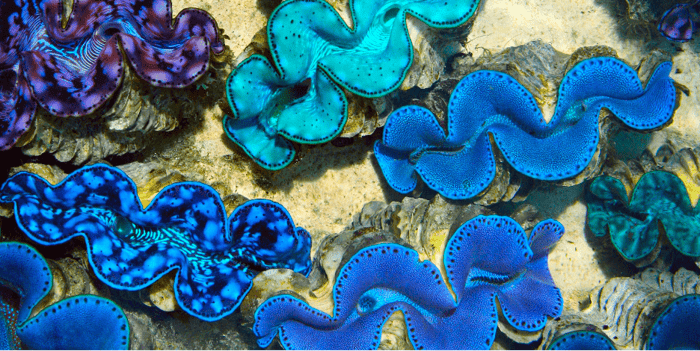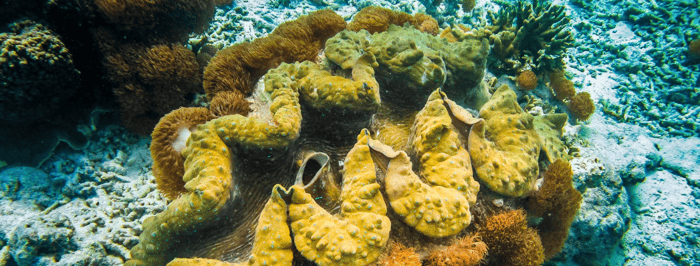Understanding giant clams: Taxonomy and Reproduction

Jordan
3
min. read
-1.png?width=950&name=IMARCS-Short-Brochure-Edited-1%201%20(1)-1.png)
Abstract
Giant clams, comprising the genera Hippopus and Tridacna, are charismatic and ecologically significant members of tropical coral reef ecosystems. This article provides a comprehensive examination of the taxonomic diversity, reproductive strategies, and ecological importance of giant clams, with a focus on their evolutionary adaptations and the conservation challenges they face amidst environmental change. Taxonomically, giant clams exhibit a remarkable array of species within the genera Hippopus and Tridacna, each characterized by unique morphological features, shell patterns, and ecological niches. The taxonomy of giant clams is continually evolving, with ongoing research elucidating the genetic relationships and evolutionary history among different species and populations. Reproductive strategies vary among giant clam species, with adaptations observed to optimize reproductive success in dynamic reef environments. Hermaphroditism and broadcast spawning are common reproductive traits, allowing giant clams to release millions of eggs and sperm into the water column during synchronized spawning events. However, variations in spawning behavior and timing exist among species, reflecting adaptations to local environmental conditions and reproductive pressures.
Giant clams, comprising the genera Hippopus and Tridacna, are charismatic and ecologically significant members of tropical coral reef ecosystems. This article provides a comprehensive examination of the taxonomic diversity, reproductive strategies, and ecological importance of giant clams, with a focus on their evolutionary adaptations and the conservation challenges they face amidst environmental change. Taxonomically, giant clams exhibit a remarkable array of species within the genera Hippopus and Tridacna, each characterized by unique morphological features, shell patterns, and ecological niches. The taxonomy of giant clams is continually evolving, with ongoing research elucidating the genetic relationships and evolutionary history among different species and populations. Reproductive strategies vary among giant clam species, with adaptations observed to optimize reproductive success in dynamic reef environments. Hermaphroditism and broadcast spawning are common reproductive traits, allowing giant clams to release millions of eggs and sperm into the water column during synchronized spawning events. However, variations in spawning behavior and timing exist among species, reflecting adaptations to local environmental conditions and reproductive pressures.

1. Taxonomy
Giant clams exhibit remarkable taxonomic diversity, with twelve described species classified within the genera Hippopus and Tridacna. Taxonomic classification is primarily based on morphological features, shell characteristics, and genetic analysis, elucidating the evolutionary relationships among different species.
Within the genus Hippopus, two species are recognized: Hippopus hippopus (bear paw clam) and Hippopus porcellanus. These species are characterized by their distinctive shell morphology, featuring elongated and irregularly shaped valves adorned with prominent ridges. The mantle tissues of bear paw clams often exhibit hues of brown, green, or blue, enhancing their camouflage within reef habitats.
The genus Tridacna comprises the majority of giant clam species, with ten recognized taxa, including Tridacna gigas (giant clam), Tridacna squamosa (fluted giant clam), and Tridacna maxima (small giant clam), among others. Tridacna gigas, renowned as the largest species of giant clam, can reach lengths exceeding one meter and weights exceeding 200 kilograms. Its shell, adorned with intricately patterned ridges, serves as a hallmark of coral reef biodiversity.
Taxonomic categorization of giant clams extends beyond species-level classification, encompassing subspecies and regional variants distinguished by subtle morphological differences and genetic divergence. Furthermore, ongoing research utilizing molecular techniques such as DNA sequencing continues to refine our understanding of giant clam taxonomy, revealing cryptic species and genetic relationships previously unknown.

The fleshy inside of a giant clam. Image credit: Stephanie Levy

The fleshy inside of a giant clam. Image credit: Stephanie Levy
2. Reproduction
Giant clams exhibit a diverse array of reproductive strategies, with variations observed among different species and populations. While the overarching reproductive strategy of giant clams is characterized by hermaphroditism and broadcast spawning, specific adaptations and spawning behaviors vary among taxa.
Tridacna gigas, the iconic giant clam species, exemplifies the remarkable fecundity and synchronous spawning behavior observed in many giant clam species. During spawning events, Tridacna gigas releases millions of eggs and sperm into the water column, timed to coincide with lunar phases and optimal environmental conditions conducive to fertilization and larval dispersal.
In contrast, species such as Tridacna squamosa exhibit variations in spawning behavior, with asynchronous spawning observed among different populations. This adaptation allows for increased reproductive success in fragmented reef habitats, where environmental cues may vary spatially and temporally.
The reproductive success of giant clams is influenced by various environmental factors, including water temperature, light intensity, and food availability. Habitat degradation and anthropogenic disturbances pose significant threats to reproductive success, disrupting spawning cues and larval recruitment processes.
Understanding the intricacies of giant clam reproduction is essential for informing conservation strategies aimed at preserving their populations and the coral reef ecosystems they inhabit. By elucidating the reproductive biology of different species and populations, researchers can identify priority areas for conservation and management, ensuring the long-term survival of these iconic marine organisms.


Giant colorful clam Tridacna gigas grows in the bottom in Raja Ampat, Indonesia. — Photo by igor_tichonow
3. Summary
The taxonomic diversity of giant clams, encompassing the genera Hippopus and Tridacna, highlights their evolutionary adaptations and ecological importance within coral reef ecosystems. These bivalves exhibit a range of morphological characteristics and shell patterns, reflecting their diverse ecological niches and genetic relationships. Taxonomic studies utilizing molecular techniques such as DNA sequencing continue to refine our understanding of giant clam taxonomy, revealing cryptic species and genetic diversity previously unrecognized.
Reproductive biology plays a pivotal role in the survival and persistence of giant clam populations. Hermaphroditism and broadcast spawning are common reproductive traits observed in giant clams, enabling synchronized release of gametes into the water column during spawning events. However, variations in spawning behavior and timing exist among species, reflecting adaptations to local environmental conditions and reproductive pressures. Understanding the intricacies of giant clam reproduction is crucial for informing conservation strategies aimed at preserving their populations and the coral reef ecosystems they inhabit.
Continued research efforts focused on elucidating the taxonomic relationships and reproductive strategies of giant clams are imperative for informing conservation initiatives. By gaining insights into their evolutionary history and ecological roles, researchers can develop targeted management strategies to mitigate the threats posed by habitat degradation, overexploitation, and environmental change. Collaborative conservation efforts involving government agencies, research institutions, and local communities are essential for safeguarding the future of giant clams and the biodiversity of coral reef ecosystems for generations to come.
Further reading:
Lucas, J.S., & Southgate, P.C. (2003). Aquaculture: Giant Clams in Asia and the Pacific. ACIAR Monograph No. 94.
Neo, M.L., Eckman, W., Vicentuan, K., & Teo, S.L.M. (2015). The ecological significance of giant clams in coral reef ecosystems. Biological Conservation, 181, 111-123.
Huang, D., Meier, R., Todd, P.A., & Chou, L.M. (2008). Slow mitochondrial COI sequence evolution at the base of the metazoan tree and its implications for DNA barcoding. Journal of Molecular Evolution, 66(2), 167-174.
Gosliner, T.M. (1987). The genus Tridacna (Gastropoda: Tridacnidae) in the Indo-Pacific. The Veliger, 29(4), 358-395.
Lin, S., Cheng, P.J., & Chen, H.C. (2016). Aquaculture of Giant Clams (Bivalvia: Tridacninae) – Successes and Constraints. Journal of Oceanography and Marine Research, 4(1), 1-7.
Neo, M.L., Eckman, W., Vicentuan, K., & Teo, S.L.M. (2015). The ecological significance of giant clams in coral reef ecosystems. Biological Conservation, 181, 111-123.
Huang, D., Meier, R., Todd, P.A., & Chou, L.M. (2008). Slow mitochondrial COI sequence evolution at the base of the metazoan tree and its implications for DNA barcoding. Journal of Molecular Evolution, 66(2), 167-174.
Gosliner, T.M. (1987). The genus Tridacna (Gastropoda: Tridacnidae) in the Indo-Pacific. The Veliger, 29(4), 358-395.
Lin, S., Cheng, P.J., & Chen, H.C. (2016). Aquaculture of Giant Clams (Bivalvia: Tridacninae) – Successes and Constraints. Journal of Oceanography and Marine Research, 4(1), 1-7.